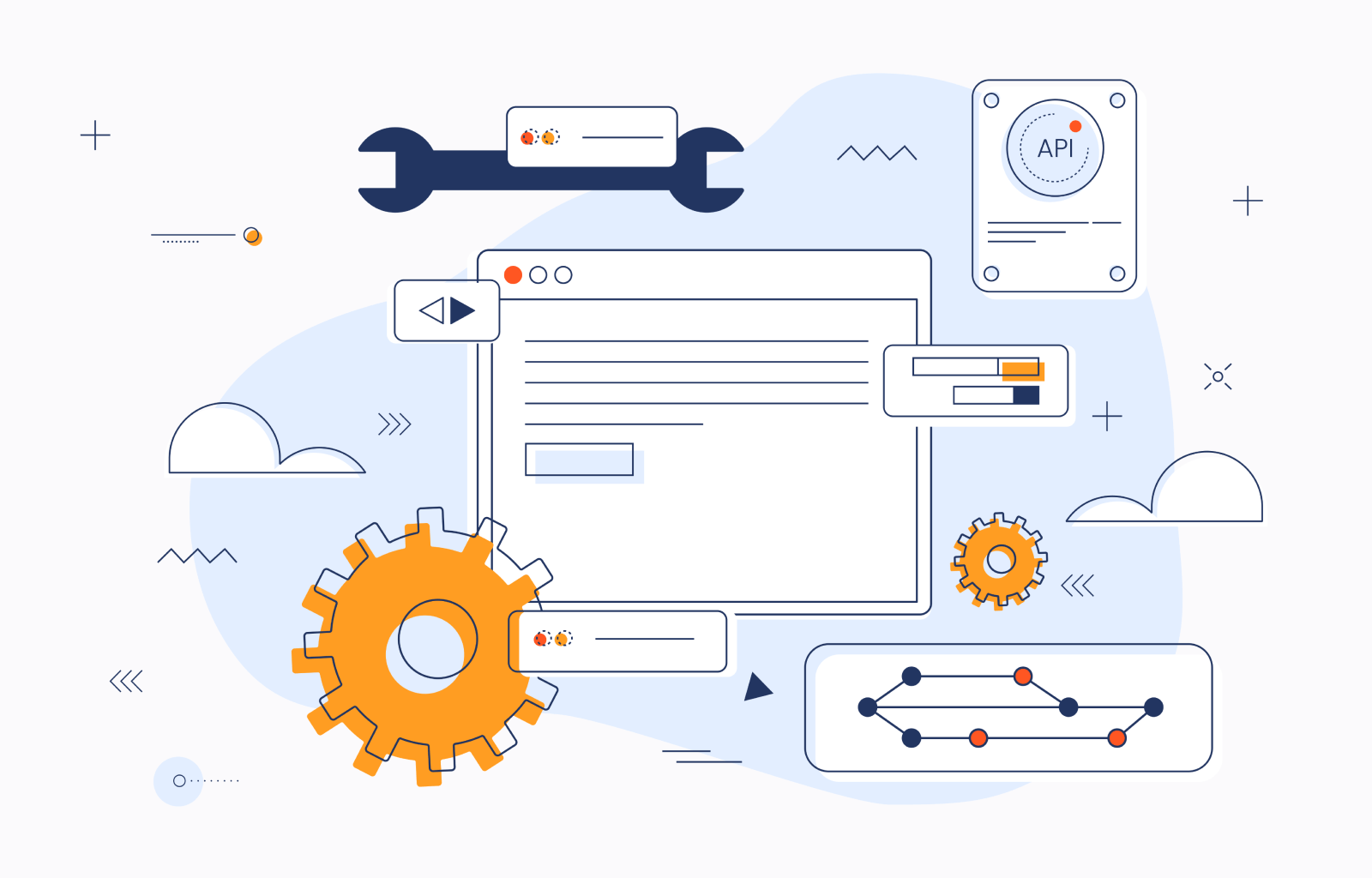The API-First Approach: Why Designing APIs Early Leads to Better Software

API-first development has become a significant trend in software creation. As Cloudflare's 2024 API Security and Management Report highlights, 57% of internet traffic processed by this company is currently composed of API requests. While the traditional approach focuses on the UI or back-end logic, API-first prioritizes designing and creating well-defined APIs as the foundation of software projects.
APIs (Application Programming Interfaces) allow developers to create more modular, scalable, and reusable software. They act as bridges between different components of an application, ensuring consistency. The API-first approach also allows faster development cycles and easier integration with third-party services. So, does this trend make sense? This guide will explore its benefits, best practices, and real-world success stories.
Why API-First Matters?
API-first development prioritizes designing and creating well-defined APIs. This approach avoids rushing to build a complete app and adding an API as an afterthought. Instead, it lets you focus on the value of APIs to your business to make your solution more flexible and adaptable. Payment processing, automation, and many other things become easier to set up.
APIs are not one-time projects. They are ongoing initiatives. They need constant updates and maintenance. As essential building blocks, APIs can offer many benefits, including:
Consistency
APIs allow a standard way to interact with software, regardless of platform or device. This ensures a consistent user experience across web, mobile, and desktop applications. It is easier for developers, too, as APIs simplify code by hiding complex details. They let engineers build apps that work on many platforms with few changes. It helps you ensure a more inclusive and accessible user experience.
01.Uniform User Experience
APIs ensure your apps provide a consistent experience across devices and platforms. This consistency builds trust and satisfaction among users, enhancing your brand's reputation. APIs help by standardizing interactions. This makes it easier for users to navigate and use your services.
02.Standardized Data Management
APIs enforce standard data formats and protocols. They simplify data management and reduce discrepancies, which is vital for industries that rely on data-driven decisions. It ensures accuracy in reporting and analytics since APIs simplify data exchange between systems.
03.Reliable Performance and Security
Developers design APIs for specific tasks focused on reliability and performance. They design them with security in mind. APIs have features like authentication, encryption, and access control. They can help businesses by ensuring operations are consistent and secure. This protects sensitive data and maintains customer trust.
Faster Development
APIs promote a microservices architecture. They create an independent environment for developing and testing different app components. This accelerates the development process and reduces the possibility of errors.
Additionally, many apps can reuse APIs, so you save as you don’t need to reinvent common functions. This improves development efficiency. Also, different teams can work on different parts of the app at the same time as long as they follow the API contract. This enables faster development cycles and shorter time-to-market.
Better Developer Experience
API-first development has many benefits for developers. So, it is a preferred way to build modern software. Here's why:
Well-documented APIs help developers to add new features to the software. They reduce the learning curve and boost productivity.
A great developer experience includes self-service features. These are easy onboarding, API key generation, and a playground for testing calls. Developers can start work right away and explore the API.
A well-maintained API is stable and responds as expected. This ensures a positive developer experience. Consistent performance, clear versioning, and backward compatibility are essential.
Clear, actionable error messages can greatly improve the developer experience. They help with debugging and problem-solving.
A well-designed API has clear paths, methods, and parameters. This helps developers navigate and use the API with skill.
Code generation for various languages or software developer kits (SDKs) shows a commitment to developers.
Lower Risk of Failure
An API-first approach can significantly reduce the risk of API failure, particularly caused by poor customer experience. By keeping this strategy, organizations can ensure that it is well-designed, well-documented, and meets all the specific needs of its intended audience.
Balancing Business and Customer Needs
An API-first mindset focuses on the product, not the tech or marketing. This creates an organization committed to its API product's success. By prioritizing product-mindedness, internal teams can iterate. They can do so based on consumer needs and business potential. This balance is essential for the long-term health and success of the API.
A Self-Selecting Evolutionary Approach
API-first design fosters a mindset of evolution and adaptation. Focusing on the product helps organizations understand customers and market needs. This enables them to effectively evangelize their API and drive adoption.
Best Practices for API-First Development
API-first development needs teamwork, good documentation, and version control for success. By following these best practices, organizations can reap the full benefits of an API-first approach. They can then build high-quality, scalable, and secure software.
Collaborative Planning
To ensure your API meets your users' needs, involve stakeholders from the start. This includes end users, business teams, designers, developers, infrastructure teams, and others.
Collaborating with stakeholders can provide valuable insights. You'll get feedback about data needs, access controls, and potential API use cases. This will lead to a more effective and successful API.
API Documentation
API documentation is a vital deliverable that directly impacts the success of an API. A compelling story can help. Teams can provide context by documenting the API's purpose, audience, and use cases. This helps developers grasp the API's potential. It's vital to keep the docs up to date. It builds trust and ensures they reflect the API's current state. The 2023 State of the API Report found a lack of documentation as the top obstacle to API usage.
Make API docs clear and concise. Avoid excessive technical jargon. A thorough description of the API's functions and purpose can help. It shows developers, CTOs, and other stakeholders their value and potential.
Need a team to handle your project's API-first development properly? Reach out to Integrio to hire dedicated software developers.
Version Control
Version control is a fundamental practice in API development that helps manage changes to the API's codebase over time. It boosts quality, maintainability, and compatibility.
One option is to follow semantic versioning (SemVer) to show version changes. You should also maintain backward compatibility whenever possible.
Continuous Testing
A comprehensive testing strategy is essential for ensuring the quality and reliability of your API. It should include unit, integration, and performance testing during development. Thoroughly testing your API can improve its functionality and reliability. It will also enhance its scalability.
Developers play a crucial role in the success of your API. A well-made developer portal can greatly improve the developer experience. It should have clear, interactive docs, code samples, tutorials, and test sandboxes. These resources will empower developers to use and integrate your API into their apps.
Looking to build a high-quality API? Integrio's Web App Development Services can help. We offer comprehensive testing services to ensure your API delivers exceptional performance and reliability.
Zero Trust
The growing reliance on APIs has highlighted the critical need for robust cybersecurity measures.A Zero Trust security model has emerged as a vital way to reduce risks. It prioritizes strict identity verification and security checks for every API request.
API gateways are key to implementing Zero Trust. They go beyond traffic management to ensure strong security. For example, a financial services firm employs Zero Trust security principles to protect its APIs. Then all requests its APIs, no matter their source, undergo strict authentication and authorization.
The Integration of AI in API Development
AI changes the way we approach software creation, including API development. AI-powered platforms automate complex tasks and provide insights. They streamline workflows, leading to more innovative, self-optimizing integrations.
For example, a retail company uses an AI platform to automate its inventory system. It integrates with various sales channels. The platform uses AI to optimize product recommendations and predict demand. It also ensures accurate inventory levels.
API-first Strategy Adopters
Many top companies now see the power of an API-first strategy, using it to innovate, expand their markets, and build partnerships. By prioritizing well-designed, accessible APIs, these companies have found new opportunities and long-term success.
One case is Stripe, a top payment platform that helps businesses of all sizes accept online payments. More than 14000 platforms and marketplaces are actively using one of their main products for payments - Connect. It's a prime example of a company that has successfully adopted API-first approach and focused on building a robust and flexible API. It has helped them quickly expand their products and integrate with many third-party apps.
Twilio is another company that has achieved significant success through its API-first strategy. They have a cloud-based platform for communication. It lets developers add SMS, voice, and video to their apps. Twilio's developer-friendly API has attracted a large, active developer community. This has driven rapid adoption and growth. More than 167 billion messages are sent and received yearly with their next-generation messaging services.
Challenges and Solutions
Despite numerous benefits, API-first development also has challenges that organizations have to address. Here are some common hurdles:
For projects with tight deadlines, designing APIs before building the app can seem slow.
API-first development can add complexity to projects. This is true for teams new to this approach. Managing API versions, ensuring compatibility, and addressing security concerns can be challenging.
Adopting an API-first mindset may need a cultural shift.
If resources are scarce, focusing on the most critical APIs and building them can be tough.
Testing APIs to ensure they work as expected can be time-consuming. It also takes time to fix any bugs or performance issues.
In the preceding sections, we presented a collection of best practices to effectively address the challenges in API-first development. These guidelines enable the creation of high-quality, scalable APIs.
Conclusion
API-first development offers many benefits, including improved scalability, reusability, and time-to-market. But it also requires planning, complexity, and a cultural shift.
Integrio can help your organization address these challenges and successfully adopt an API-first approach. Our team of experts can:
Design and develop custom APIs tailored to your specific needs.
Integrate APIs with existing systems and applications.
Develop custom software from the ground up.
Provide custom enterprise software solutions and IT project outsourcing.
Contact us to kick-start your project!
Contact us

